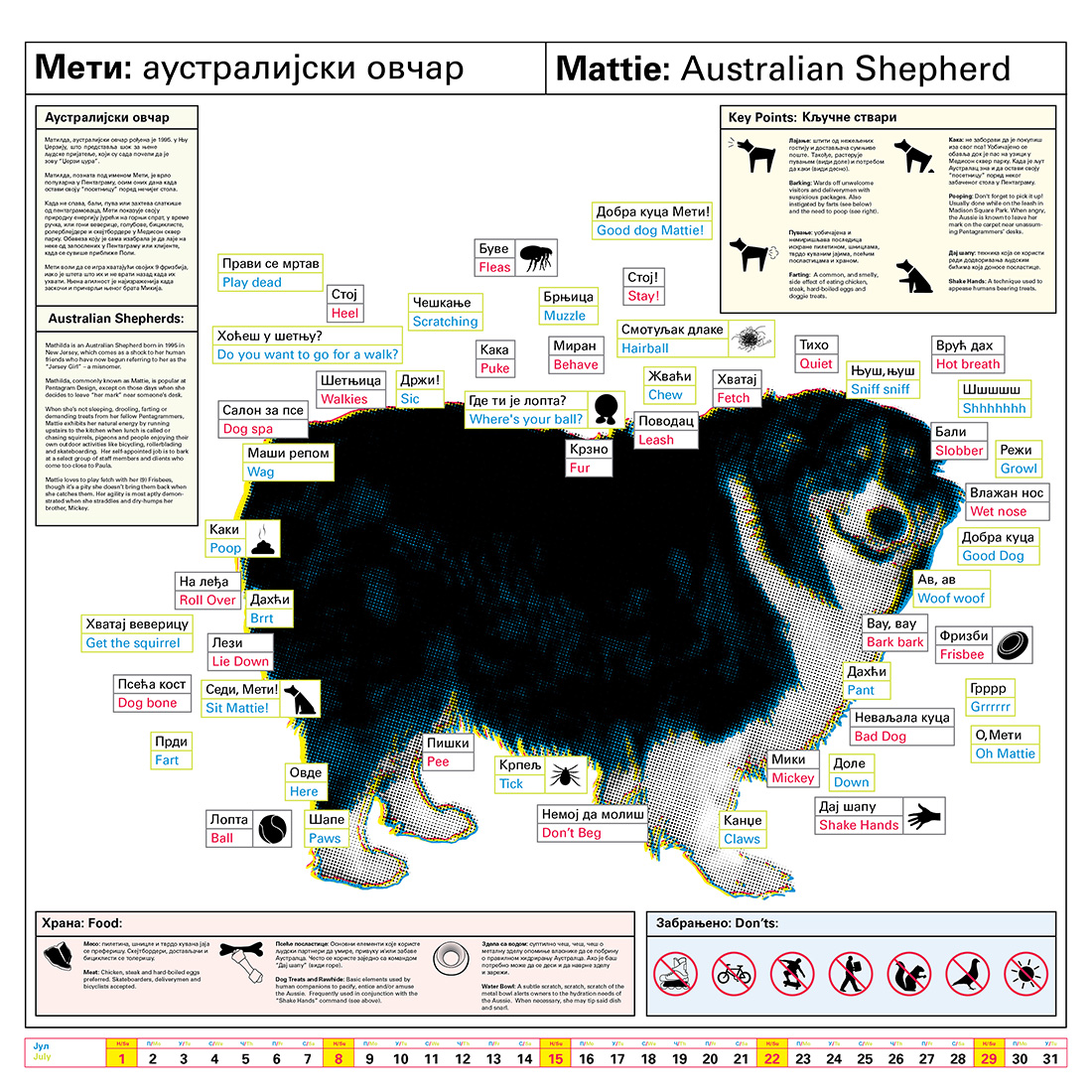The 1990s in the former Yugoslavia were a time of war and deprivation. The Balkan Wars in that region caused some 130,000 deaths and affected millions of lives. From this terrible time of Slobodan Milosevic’s regime came a project that continues through today to illustrate that art and design can help heal a war-torn community and become an international cultural event.
The Publikum Calendar was developed by the FIA Art Group for the Belgrade-based offset lithographic printer, Publikum, under the creative direction of Djordje Milekic. Milekic, who also practiced under the artistic names Stanislav Sharp as a photographer, conceived of this extraordinary project, along with his partner Nada Ray, as a means to promote Serbian culture. “All projects that I was working on in the ’90s were produced by my partner Nada who has served as the Publikum Calendar editor and project manager from the start,” says Milekic. “We founded the FIA Art Group studio, which specializes in nonprofit and cultural projects, and have worked in collaboration with many other artists.”
The calendar pages have been filled with work created by over 100 Serbian designers, artists, and photographers including Slavimir Stojanovic, Borut Vild, Igor Orsolic, Aleksandar Kujucev, Goranka Matic, Vladimir Peric Talent, and Dragan Papic; as well as non-Serbians like illustrator Andrea Drezsö, designers Karlssonwilker, Mirko Ilic, and currently, Pentagram’s Paula Scher. Each of the calendars is given a unique title and is designed by a different person.
Since the calendar is a nonprofit project, all the artists generously donate their work free of charge. Over the years, Publikum has provided an unprecedented level of support for the project, allowing FIA and their collaborators to have complete freedom of expression. “We couldn’t have done it without their enlightened support,” says Ray, “They didn’t meddle—they trusted us. They provided unique corporate patronage in the truest sense.”

POP CULTURE ICON BJöRK IS JUST ONE OF MANY INTERNATIONALLY RENOWNED ARTISTS WHO HAVE LENT THEIR SUPPORT TO THE PUBLIKUM CALENDARS. ARTISTS ARE DRAWN TO THE PROJECT BELIEVING THAT CREATIVITY WILL HELP OVERCOME WAR AND ISOLATION. THESE CALENDARS ARE A PRIVATE INITIATIVE IN A SERBIAN SOCIETY THAT HAS NOT BEEN ABLE TO INVEST IN ITS OWN CULTURE FOR YEARS.
PUBLIKUM CALENDAR ‘ANTIWALL’. CALENDAR DESIGN: MIRKO ILIC. IMAGE OF BJöRK: ME COMPANY.
MAKING A STATEMENT
Publikum, with its Latin origin, is a powerful word that in Serbian refers to both public and publishing. “Publikum Calendar is an art project. It’s public debate on cultural and political issues. It’s a happening. It’s an examination of public communication,” says Douglas Atkin, author of the book The Culting of Brands. “It’s a series of personal stories told by creative philosophers. Oh, and you can tell what date it is.” From the beginning, the project was always intended to be more than a printer’s promotional piece. Through calendar themes and artwork, the live art performance events that launch the calendars each year, and the subsequent documentaries, TV shows, exhibitions, and books that are companion pieces, the Publikum Calendar has galvanized the creative community in Serbia, drawing international attention to the condi- tions Serbian artists work under.
“We wanted to create an artistic reflection of what was happening in the turbulence of the ’90s. During those years, the calendar was the only, or certainly the largest, art publishing project and cultural event in poor, war-torn Serbia. For many people it represented a source of hope that we could stay sane in harsh times. It was an ‘oasis of creativity,’” Milekic states. “It was escape for many Belgrade creatives, as well as ordinary people, from the terrible things that were happening around us that we had no control over. Artists who had their work published in the calendar had a rare opportunity to reach wide audiences.” As Vesna Petrovic, a Serbian designer now living in Los Angeles puts it, “Calendars are such a predictable promotional piece for all kinds of businesses in Eastern Europe, but FIA took an expected utilitarian item and turned it into an unexpected cultural phenomenon.”
When the Gallery Sebastian, which had been the epicenter of avant-garde art in Belgrade, was destroyed by one of then-president Milosevic’s henchmen, the FIA Art Group launched the Publikum Calendar in 1993 at the site’s ruins as an artistic protest that was also a message of solidarity with all the displaced Yugoslavians who had been impacted by war.
“As an artist, you are part of the society that you live and work in. We had to make a statement about the craziness going on around us. At that time, Serbia had the largest inflation in history with a bill [currency] that had 13 zeroes on it—but you couldn’t buy one liter of milk. The average salary was $10 a month, and there were hundreds of thousands of homeless immigrants. All these things were consequences of those wars. These conditions impacted us, and shaped the project,” recalls Nada Ray.
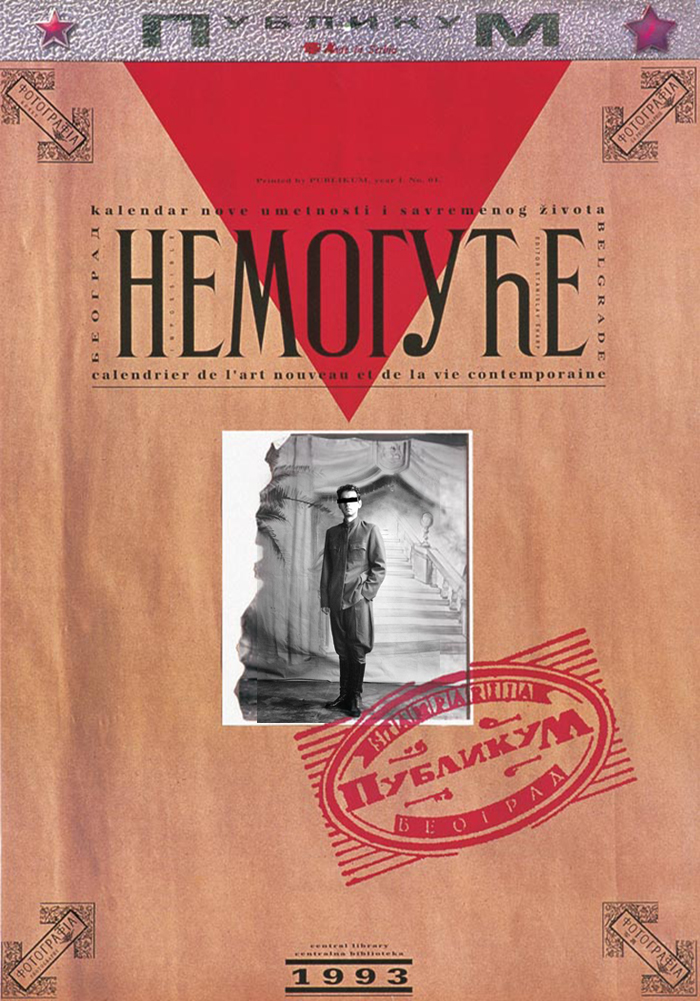

THE FIRST PUBLIKUM CALENDAR, CALLED IMPOSSIBLE, WAS ART DIRECTED, DESIGNED, AND CONTAINED PHOTOGRAPHY BY DJORDJE MILEKIC (STANISLAV SHARP). THIS 1993 CALENDAR BLENDS TRADITIONAL SERBIAN VISUAL ELEMENTS WITH CONTEMPORARY PORTRAITURE TO CONVEY A NOSTALGIC SURREALISM TRIGGERED BY THE COUNTRY’S POLITICAL AND ECONOMIC FREEFALL.


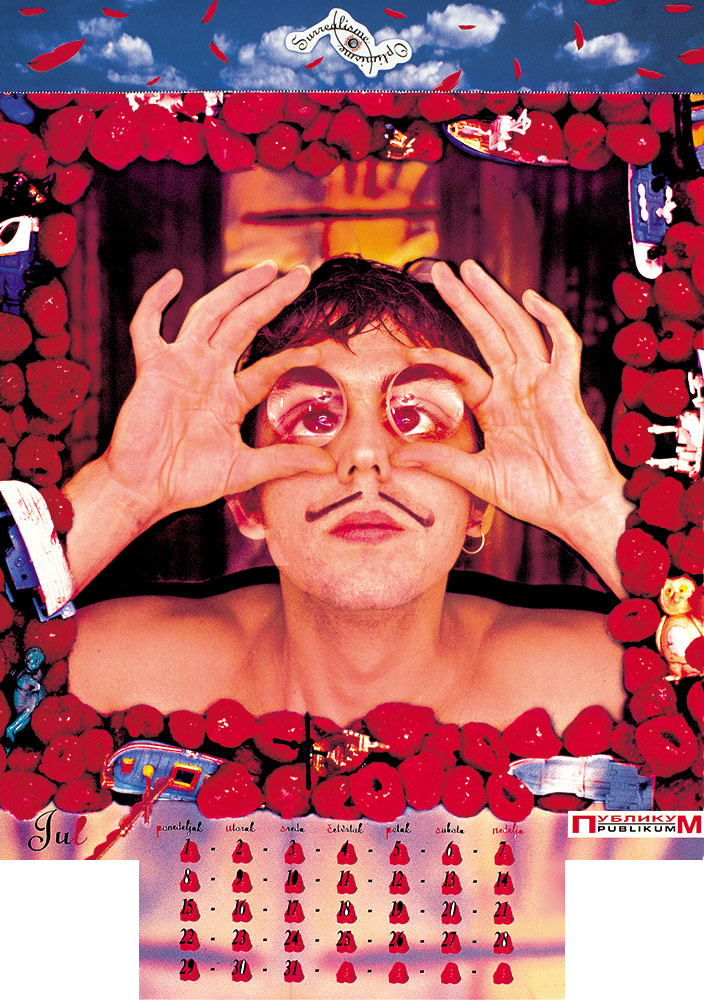
TOP LEFT: THE 1995 CALENDAR, LIFE IN MOTION, FEATURED PHOTO COLLAGES BY VARIOUS BELGRADE ARTISTS, LIKE THIS ONE BY DESIGNER JELENA TRPKOVIC, WHICH REFRACTED THE TURBULENCE OF THE TIMES. BOTTOM LEFT: THAT YEAR MINI-BOTTLES OF GASOLINE, A RARE COMMODITY ONLY AVAILABLE ON THE BLACK MARKET, WERE AWARDED AS PRIZES AT THE CALENDAR’S LAUNCH PARTY.
TOP RIGHT: SURREALISM & OPTIMISM, THE 1996 PUBLIKUM CALENDAR, DESIGNED BY SLAVICA DRAGOSAVAC WITH PHOTOS BY DJORDJE MILEKIC (STANISLAV SHARP), IS A COLLECTION OF PORTRAITS OF PUBLIC FIGURES AND ANONYMOUS PEOPLE WHO HAD THE COURAGE TO BE OPTIMISTS IN SPITE OF THE SURREAL ATMOSPHERE IN SERBIA IN THE 90S.
CROSSING CULTURAL BORDERS
“Over the years, most of the exhibitions of the Publikum Calendar artworks have occurred in public places and were seen on average by 15,000 visitors annually. In a country where people don’t have the habit of going to galleries and museums this was an extraordinary result,” adds Djordje Milekic. (The average number of visitors to a typical Serbian gallery or museum is a couple hundred people a month.) The Publikum Calendar continues to be printed and premiered in Belgrade. It is distributed to a select mailing list of 2,000 each November, but it now reaches millions with shows about it on Serbian television each year. In addition, audiences throughout the world experience the artwork via the project’s website: www.artkalendar.com. The 2007 Publikum Calendar, Paula Scher’s “Gobbledy-gook” (experiments in alphabet form and meaning), is scheduled to be launched at the Museum of Contemporary Art in Belgrade on Nov. 7, then at the New York Art Director’s Club on Nov. 28.
“In the ’90s, politics played a major role in everyday life in Serbia. In this period, the calendars and their launch events were very much a reflection of that. Living in poverty and impossible circumstances was a big inspiration to us. With the democratic changes that occurred in Serbia in 2001, we felt that it was time for a change in our project, too,” says Milekic, “It became time to incorporate new, positive ideas and ways of thinking about ourselves and about the country.” Since 2001, the Publikum Calendar has acted as a cultural bridge, bringing artists and designers from other parts of the world to the project in an exchange of ideas and energies. They speak to a whole generation of Serbs who have been deprived of international culture because of the Balkan Wars.
“We want to bring different ways of thinking and surprising new solutions to the calendars in order to influence young Serbian artists,” Milekic says. In addition, special-edition books were created after 2001 in order to broaden the project. These accompanying books showcase more works by the calendar artists, sometimes revealing the process of the calendars’ making, and are delightful objects in themselves.
“We set out to create something that was going to benefit everybody and also be promotional advertising for Publikum, the company,” says Milekic. The calendar has brought something special into the art and design world. The project continues now, working to help Serbians hungry for access to the rest of the world’s creative ideas to satisfy their curiosity and desire to belong to an international art community. “Art can change the world, we believe in that,” he concludes, “As a matter of fact, even in the worst times of the ’90s, when Serbia was under economic, political, and even a cultural blockade by the U.N., there was a significant flow of art projects that were addressing war and political and economical issues. For art and design, there are no borders.”
ANTIWALL, THE 2001 PUBLIKUM CALENDAR, FEATURED THE WORKS OF 12 INTERNATIONALLY RENOWNED ARTISTS, INCLUDING WIM WENDERS, OLIVIERO TOSCANI, BARBARA KRUGER, CHRISTO, BJöRK, TADONORI YOKO, AND DAVID BYRNE. DJORDJE MILEKIC AND NADA RAY CHANGED THE PUBLIKUM CALENDAR’S FOCUS TO BE A CULTURAL BRIDGE BETWEEN SERBIA AND THE REST OF THE ART WORLD INSTEAD OF ONLY FEATURING SERBIAN ARTISTS’ WORKS. ART DIRECTION AND DESIGN: MIRKO ILIC.
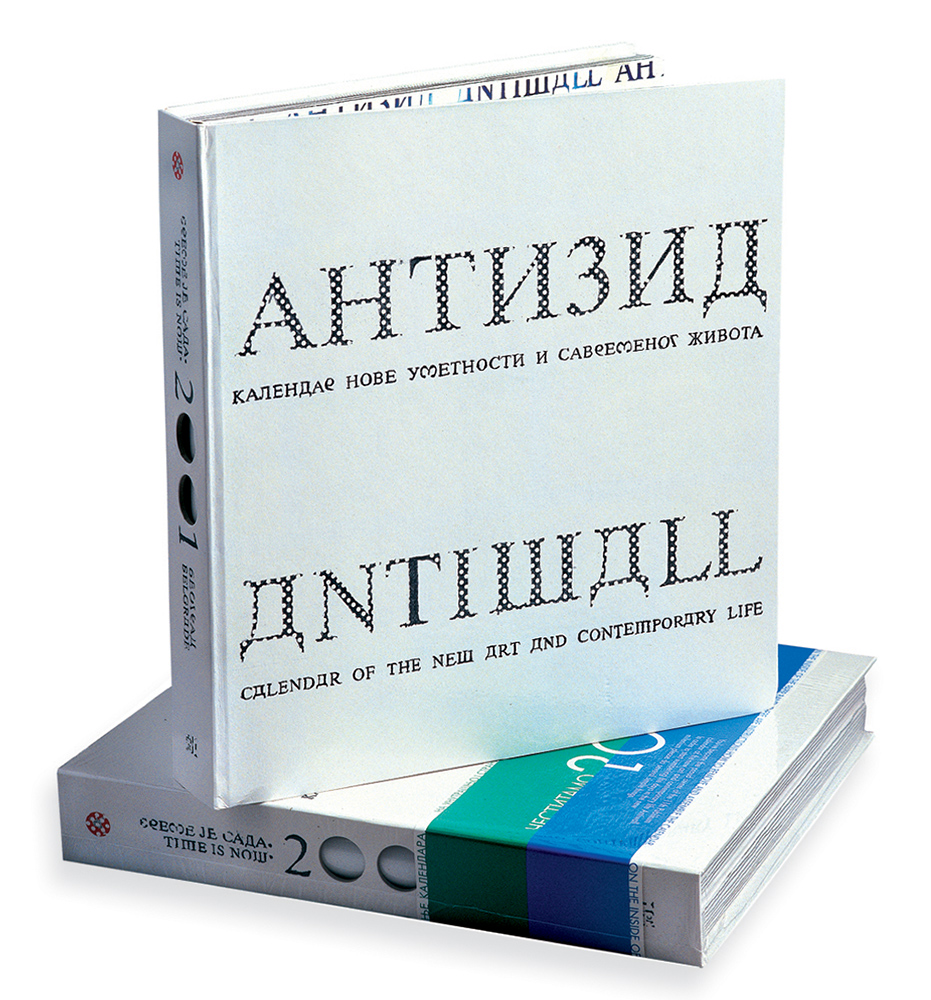

BELOW: ILIC CREATED THE SPECIAL ANTIWALL PUBLIKUM CALENDAR FONTS, CIFFRILICA AND ENGLIC, AS SEEN HERE IN BARBARA KRUGER’S TRANSLATED ARTWORK.

BELOW: BECAUSE OF THE BALKAN WARS, MANY SERBIANS MISSED BEING EXPOSED TO IMPORTANT ART AND IDEAS OF THE LATE 1980S AND 1990S, INCLUDING THE WORK OF OLIVERO TOSCANI, WHO CHALLENGED THE ROLE OF ADVERTISING IN HIS SERIES OF SHOCKING IMAGES FOR BENETTON. ORIGINALLY PUBLISHED IN 1989, THIS IMAGE, “CONTRASTS IN BLACK & WHITE,” WAS CREATED TO PROMOTE RACIAL EQUALITY AND WAS CHOSEN BY FIA GROUP TO BE INCLUDED IN THE 2001 CALENDAR.
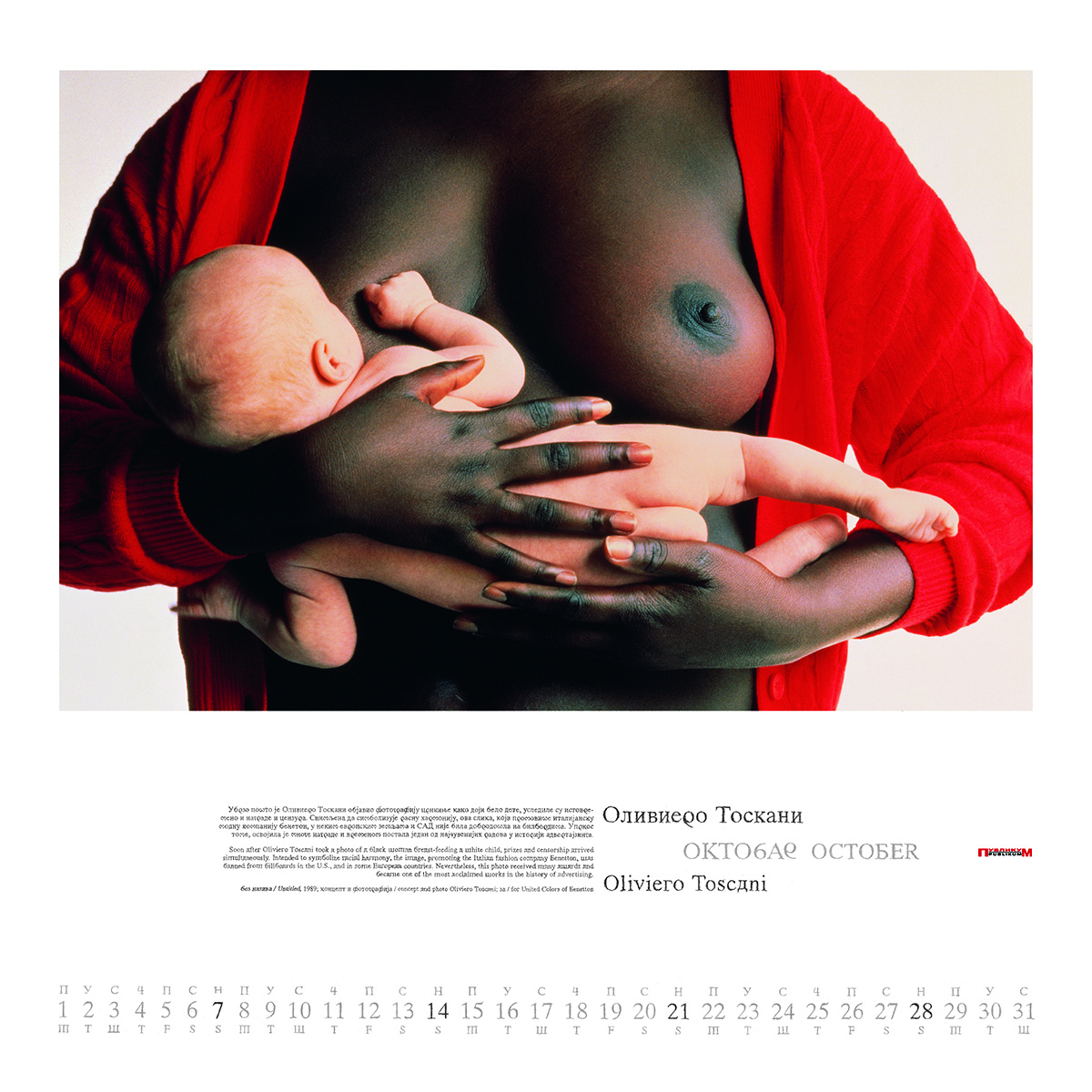
BELOW: IN THE TRADITION OF VICTORIAN ARTISTS, ROMANIAN-BORN DESIGNER/ILLUSTRATOR ANDREA DEZSö UNDERTOOK AN IMAGINARY JOURNEY TO SERBIA IN THE 2006 TALES FROM SERBIA. THE ARTWORK IS INSPIRED BY FOLK STORIES, SONGS, AND FAIRY TALES, CREATING A UNIQUE AND COLORFUL DREAM WORLD.




ABOVE AND BELOW: PHENOMEMAN, THE 2005 CALENDAR PROJECT, INCLUDED AN ACCOMPANYING BOOK, KARLSSONWILK- ER’S 12 DAyS IN SERBIA. THE NEW YORK-BASED DESIGN FIRM DEVELOPED THE BOOK WITH A BILINGUAL TEXT (SERBIAN/ENGLISH) WHERE ONE LANGUAGE IS REVEALED WHILE THE OTHER IS COVERED USING A STRIPED PLASTIC INSERT. KARLSSONWILKER RECORDED THEIR IMPRESSIONS OF SER- BIA IN TEXT AND PHOTOS, DESIGNING 12 CALENDAR PAGES IN 12 DAYS, AND THEIR TRIP ITSELF WAS AN EVENT COVERED ON SERBIAN TELEVISION.

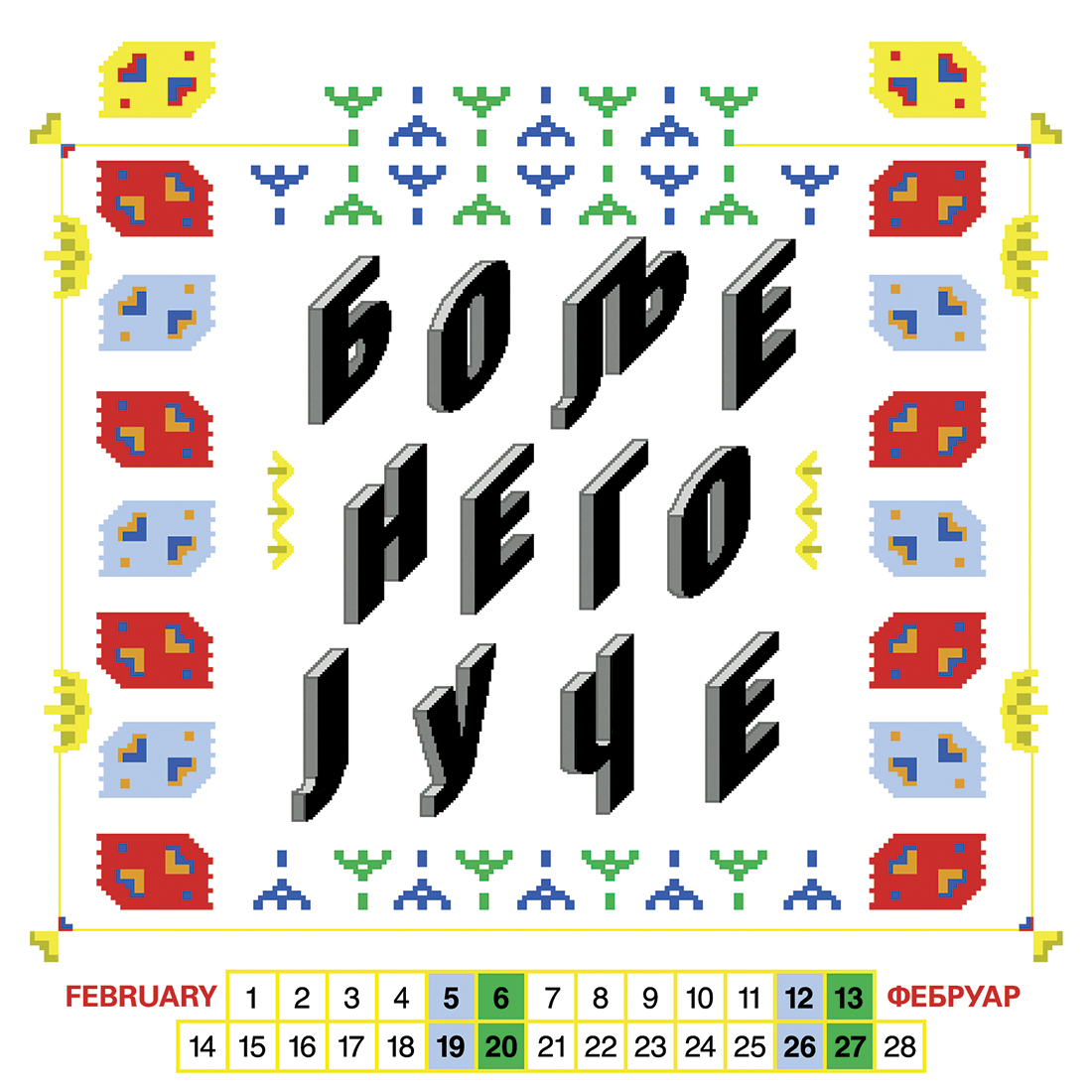
The 2007 Publikum Calendar included a book, an exhibition, lectures, documentaries, and a media campaign both in Serbia and the U.S. Richard Wilde, chairman, Advertising and Graphic Design Departments, School of Visual Arts, wrote in his introduction for the calendar: “Paula’s calendar is a visual and verbal journey that juxtaposes Cyrillic and Roman alphabets whose convergence creates a world of absurdities, anomalies, and eccentricities, as well as similarities that result in a heightened consciousness of both the Serbian- and English-speaking worlds.” Publikum Calendar creative director Djordje Milekic says, “Paula Scher did an amazing job, and I think she set a new standard in ideas and approach to the project!”
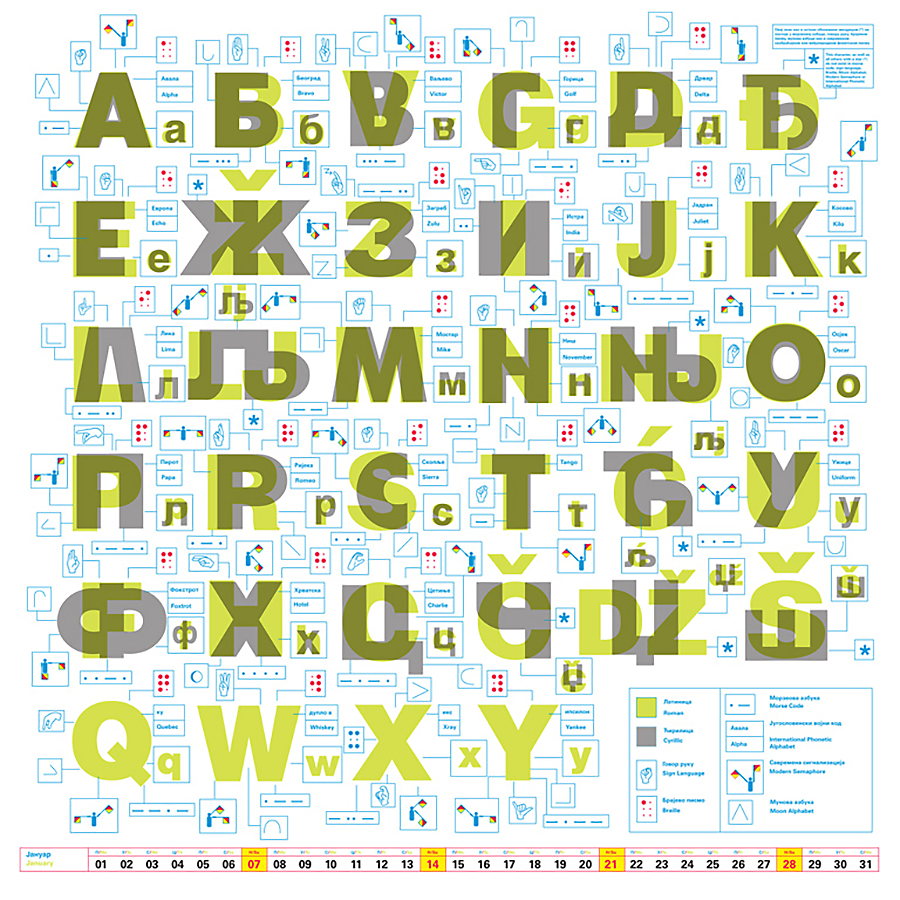
INTRODUCTION BY PAULA SCHER (EXCERPT)
“GOBBLEDY-GOOK, NONSENSE, BALDERDASH. That’s how an alphabet looks to an illiterate person. It seems impossible that the odd shapes and forms that comprise the character of letters have sounds attached to them, and that those strange sounds depicted by forms have meaning when they are strung together. I can’t read Cyrillic characters. Neither can any of the designers who work with me. The Cyrillic words on the page simply look like complete gobbledy-gook. We took this rare opportunity of accidental illiteracy to explore a foreign typeface and language (Serbian) formalistically and compare and contrast it to the one we understand (English). What follows are some typographic explorations in form and meaning.”

